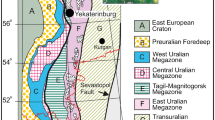Abstract
Deerite [Fe 2+12 Fe 3+6 Si12O40 (OH)10] was first discovered in the metamorphic magnetite-bearing quartzites which are interlayered with blueschists in Aksu Precambrian blueschist terrane. The deerite-bearing mineral association includes (1) deerite + riebeckite + stilpnomelane + ilvaite + magnetite + quartz and (2) deerite + stilpnomelane + magnetite +quartz based on the investigation under microscope. The study of mineral chemistry shows that the deerites from Aksu Precambrian blueschist are Mn-poor deerite similar to that from Alps. But the deerite from Aksu is the nearest to the end member of deerite. According to the equilibrium P-T region of deerite determined by Lattard and Breton (1994), the deerites in metamorphic magnetite-bearing quartzites from Aksu Precambrian blueschists were formed under the conditions of pressure lower than 1.0 Gpa, temperature ranging from 300 to 400°C and about the l0°C/km geothermal gradient.
The deerite in metamorphic magnetite-bearing quartzites from Aksu blueschists is the only one Precambrian deerite reported now. This suggests that the earth began to cool, and the modern cooling subduction regime between plates started at Late Proterozoic. The Late Proterozoic may be the important period during the evolution of the earth.
Similar content being viewed by others
References
Agrell, S. O., Bown, M. G., McKie, D., Deerite, howieite and zussmanite, three new minerals from the Franciscan of the Laytonville district, Mendocino Co., California,Am. Mineral, 1965, 50: 278.
Black, P. M., Mineralogy of the New Caledonian metamorphic rocks, II. Amphiboles from the Ouegoa district,Contrib. Mineral. Petrol., 1973, 39: 55.
Wood, R. M., The iron-rich blueschist facies minerals: I,Deerite. Mineral Mag., 1979, 43: 251.
Schliestedt, M., Preliminary note on deerite from high pressure metamorphic rocks of Sifnos, Greece,Contrib. Mineral. Petrol., 1978, 66: 105.
Vernie, P., Kienast, J. R., Mevel, C., The occurrence of deerite in highly oxidizing conditions within the schiste lustres of eastern Corsica,J. Metamorphic Geol., 1986, 4: 385.
Dong Shenbao, The general characteristics and distribution of glaucophane-schist belts in China,Acta Geologica Sinica (in Chinese with English abstract), 1989, 6: 273.
Liou, J. G., Graham, S. A., Maruyama, S. et al., Characteristics and tectonic significance of the Late Proterozoic Aksu blueschists and diabasic dikes, Northwest Xinjiang, China,International Geological Review, 1996, 38: 228.
Nakajima, T., Maruyama, S., Uchiumi, S. et al., The age of the oldest blueschist of the world-the Aksu Group of Western China,Nature, 1991, 346: 263.
Boquet, J., Forette, M. C., Sur une déerite de I’ ensemble des caleschiste piémontais, à Troncea,Bulletin de la Société Francaise de Minéralogie Cristallographie, 1973, 96: 314.
Wood, R. M., The Laytonville Quarry (Mendocino County California) exotic block: iron-rich blueschist-facies subduction-zone metamorphism,Mineral. Mag., 1982, 45: 87.
Langer, K., Lattard, D., Schreyer, W., Synthesis and stability of deerite, Fe2+ 12 Fe3+ 6 Si12O40(OH)10, and Fe3+ = Al3+ substitutions at 15 - 28 kb,Contrib Mineral. Petrol., 1977, 60: 271.
Lattard, D., Breton, N., The P-T-FO2 stability of deerite, Fe2+ 12 Fe3+ 6 Si12O40(OH)10,Contrib. Mineral. Petrol., 1994, 115: 308.
Goffe, B., Veldte, B., Contrasted metamorphic evolutions in thrusted cover units of the Brianconnais zone (France Alps): a model for the conservation of HP-LT metamorphic mineral assemblages,EPSL, 1984, 68: 351.
Brown, E. H., Geology of the Shuksan Suit, Northe Caste Washington, USA., inBlueschist and Edogite (eds. Evans, BW., Brown, E. H.), Geol. Soc. Am. Mem., 1986, 164: 143–154.
Chatterjee, N. D., Johannes, W., Leistner, H., The system CaO-Al2O3-SiO2-H2O: new phase equilibrium data, some calculation relations, and their petrological applications,Contrib. Mineral. Petrol., 1984, 88: 1.
De Rovere, Some differences between post-Paleozoic and older regional metamorphism,Geol. Mynbouw, 1956, 18: 123.
Ernst, W. G., Occurrence and mineralogic evolution of blueschist belts with time,Am. J. Sci., 1972, 272: 657.
Maruyama, S., Cho, M., Lou, J. G., Experimental investigations of blueschists-greenschist transition equilibria and their petrological applications, inGeol. Soc. Amer. Memoir, (eds. Evens, B. W., Brown, E. H.), 1986, 164: 1–16.
Xiao, X., Tang, Y., Feng, Y. etal.,The Tectonics of Northern Xinjiang and Its Adqjecent Regions, Beijing (in Chinese with English summary), Beijing: Geological Publishing House, 1992, 48–52.
Moor, E. M., Neoproterozoic oceanic crustal thinning, emergence of continents, and origin of the Phanerozoic ecosystem: A model,Geology, 1993, 21: 5.
Author information
Authors and Affiliations
Additional information
Project supported by the National Natural Science Foundation of China (Grant Nos. 49572157 and 49772103)
Rights and permissions
About this article
Cite this article
Zhang, L., Jiang, W., Wei, C. et al. Discovery of deerite from the Aksu Precambrian blueschist terrane and its geological significance. Sci. China Ser. D-Earth Sci. 42, 233–239 (1999). https://doi.org/10.1007/BF02878960
Received:
Issue Date:
DOI: https://doi.org/10.1007/BF02878960




